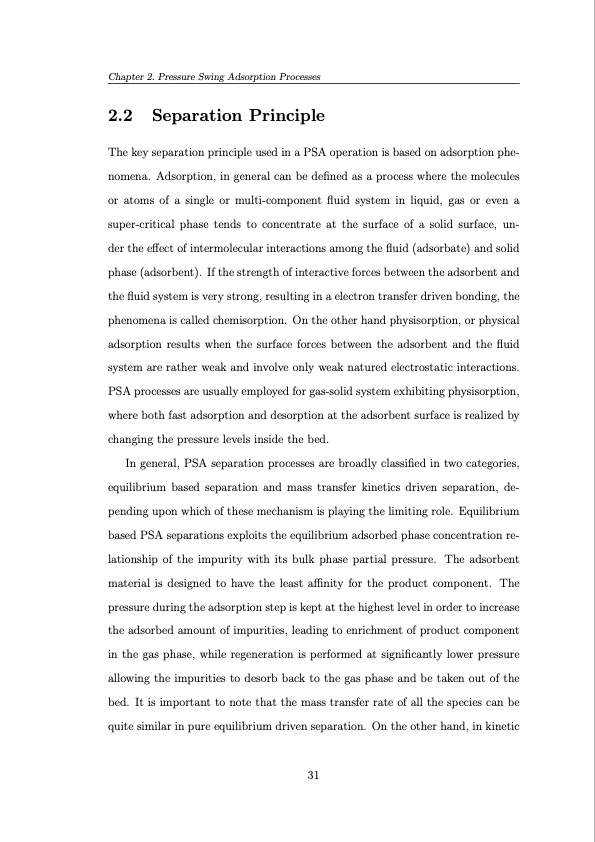
PDF Publication Title:
Text from PDF Page: 031
Chapter 2. Pressure Swing Adsorption Processes 2.2 Separation Principle The key separation principle used in a PSA operation is based on adsorption phe- nomena. Adsorption, in general can be defined as a process where the molecules or atoms of a single or multi-component fluid system in liquid, gas or even a super-critical phase tends to concentrate at the surface of a solid surface, un- der the effect of intermolecular interactions among the fluid (adsorbate) and solid phase (adsorbent). If the strength of interactive forces between the adsorbent and the fluid system is very strong, resulting in a electron transfer driven bonding, the phenomena is called chemisorption. On the other hand physisorption, or physical adsorption results when the surface forces between the adsorbent and the fluid system are rather weak and involve only weak natured electrostatic interactions. PSA processes are usually employed for gas-solid system exhibiting physisorption, where both fast adsorption and desorption at the adsorbent surface is realized by changing the pressure levels inside the bed. In general, PSA separation processes are broadly classified in two categories, equilibrium based separation and mass transfer kinetics driven separation, de- pending upon which of these mechanism is playing the limiting role. Equilibrium based PSA separations exploits the equilibrium adsorbed phase concentration re- lationship of the impurity with its bulk phase partial pressure. The adsorbent material is designed to have the least affinity for the product component. The pressure during the adsorption step is kept at the highest level in order to increase the adsorbed amount of impurities, leading to enrichment of product component in the gas phase, while regeneration is performed at significantly lower pressure allowing the impurities to desorb back to the gas phase and be taken out of the bed. It is important to note that the mass transfer rate of all the species can be quite similar in pure equilibrium driven separation. On the other hand, in kinetic 31PDF Image | Operation and Control of Pressure Swing Adsorption Systems

PDF Search Title:
Operation and Control of Pressure Swing Adsorption SystemsOriginal File Name Searched:
Khajuria-H-2011-PhD-Thesis.pdfDIY PDF Search: Google It | Yahoo | Bing
CO2 Organic Rankine Cycle Experimenter Platform The supercritical CO2 phase change system is both a heat pump and organic rankine cycle which can be used for those purposes and as a supercritical extractor for advanced subcritical and supercritical extraction technology. Uses include producing nanoparticles, precious metal CO2 extraction, lithium battery recycling, and other applications... More Info
Heat Pumps CO2 ORC Heat Pump System Platform More Info
| CONTACT TEL: 608-238-6001 Email: greg@infinityturbine.com | RSS | AMP |